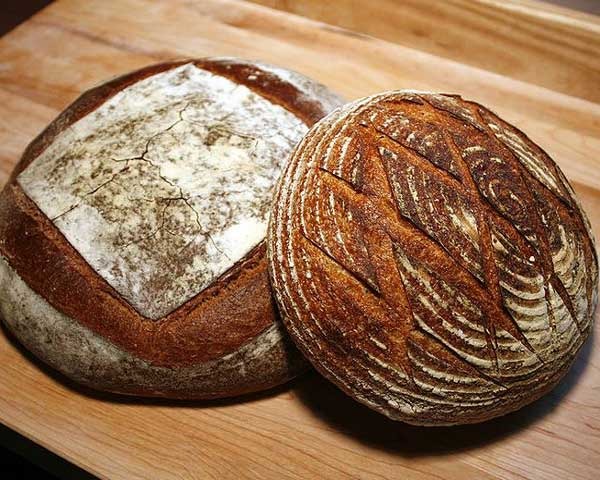The Food Almanac: Tuesday, April 1, 2014
Restaurant Anniversaries
Bozo's opened today in 1928. Founder Chris "Bozo" Vodanovich was one of many Croatians who created great restaurants in New Orleans in the 1900s. He relied on his connections with the fishermen in Plaquemines Parish to supply him with first-class oysters and other seafood. Bozo's became legendary, always packed with people waiting for the simple but meticulously fried and boiled seafood. Bozo's son–also named Chris–continued that attention to details until he sold it to Ed McIntyre in 2013. He renamed it Mr. Ed's Oyster Bar & Fish Grill and expanded the menu a bit, but the standards set by Bozo are still in place.
Food Calendar
This is Sourdough Bread Day. Sourdough is to San Francisco what New Orleans-style French bread is to our town. It's served everywhere a local flavor is desired. It's an interesting product. The making of sourdough begins with a mixture of flour and water set out in the open to capture free-floating yeasts from the air. (San Francisco is supposed to have the best airborne yeast in the world, but that has never been proven.)
The yeasts begin leavening this starter dough and multiplying. More flour and water are added–as well as milk and sometimes sugar or potato starch. When enough active starter is made, some or all of it goes into a batch of bread flour, where over a period of hours it leavens the dough. Most of that gets baked into bread, but some of it is kept unbaked, to continue feeding the yeasts. That's used to make the next day's batch of sourdough bread, and the process is repeated.
Long-time San Francisco bakers claim that their sourdough starter has been developing this was continuously for decades. All the above is the original, artisan's method of making sourdough. In actual practice, most bakers of sourdough also use a commercial baker's yeast to help the process along. (They say it improves the taste, but the purists call this a shortcut.) It's great bread, no matter how you slice it.
Gourmet Gazetteer
Meat Camp, North Carolina is 125 miles northwest of Charlotte. It's where the extremities of North Carolina, Tennessee, Virginia and Kentucky come together. That's the richest part of the country in terms of the number of towns with food names. It's rolling, mostly wooded countryside there at the junction of Meat Camp Road and Little Creek Road. Meat Camp drew settlers in 1799, and was so named because a cabin where hunters stored meat was there, on a prominent rocky patch of grown. It has always been a knot of civilization, and has a few houses and even a church. Finding a restaurant is harder. A five-mile trip up a winding country road brings you to the Mountaineer Restaurant in Trade, NC. Another eatery called Sharpie's is near there.
Edible Dictionary
concrete, St. Louis concrete, n.–A milkshake made with frozen custard and a minimum of milk. It's mixed thoroughly to become so thick that if you turn the container upside down, the milkshake will stay put. It needs to be eaten with a spoon rather than a straw. Ted Drewes Frozen Custard in St. Louis is the place most famous for it.
The Old Kitchen Sage Sez:
If you make a good yeast sponge, you are evermore committed to taking care of it the rest of your life. Or you're not a true bread baker.
Deft Dining Rule #235
A restaurant that serves just enough bread is more interested in its food cost percentages than your pleasure. [Note: Most chain restaurants don't serve bread at all anymore.]
Annals Of Food Writing
Jean-Anthelme Brillat-Savarin, physician and author of The Physiology of Taste, was born today in 1755. His witty, appreciative tome was the first modern book on the subject of fine cuisine and dining, and remains definitive. His most famous quotation was "Tell me what you eat, and I will tell you what you are." Here are two more:
"A dessert without cheese is like a beautiful woman with only one eye."
"The discovery of a new dish does more for the happiness of the human race than the discovery of a star."
Food And Sports
Rusty Staub was born in New Orleans today in 1944. After a long and distinguished career in baseball with Jesuit High School, the Astros, and the Expos, he moved to New York and was adopted by Mets fans. He was popular enough that he opened Rusty's, a restaurant that served Cajun food to New Yorkers for twenty-one years. He remains a gourmet and oenophile. A very nice guy, he is an ardent philanthropist.
The Saints
This is the feast day of St. Hugh, the patron saint of Grenoble, France. A dish noted as being the the Grenoble style almost always includes capers. It's also where the potent Chartreuse liqueur comes from. St. Hugh donated the land on which Chartreuse Abbey, where the potent beverage originated, was built. Perhaps this explains why St. Hugh is also a patron saint of headache sufferers.
Food Namesakes
Apple Computer was founded today in 1976. . . Otto von Bismarck, the chancellor of Germany in the late 19th century, was born today in 1815. (A bismarck is a kind of filled doughnut) . . . Actor Wallace Beery came out onto the Big Stage today in 1885. . . Billy Currie, who plays many instruments for the group Ultravox, was born today in 1950. . .Jim and Tammy Faye Bakker got married today in 1961.
Words To Eat By
"Ex ovo omnia. Everything from an egg."–William Harvey, British physician, born today in 1578.
Words To Drink By
"Burgundy makes you think of silly things, Bordeaux makes you talk of them, and Champagne makes you do them."–Jean-Anthelme Brillat-Savarin, born today in 1755.
